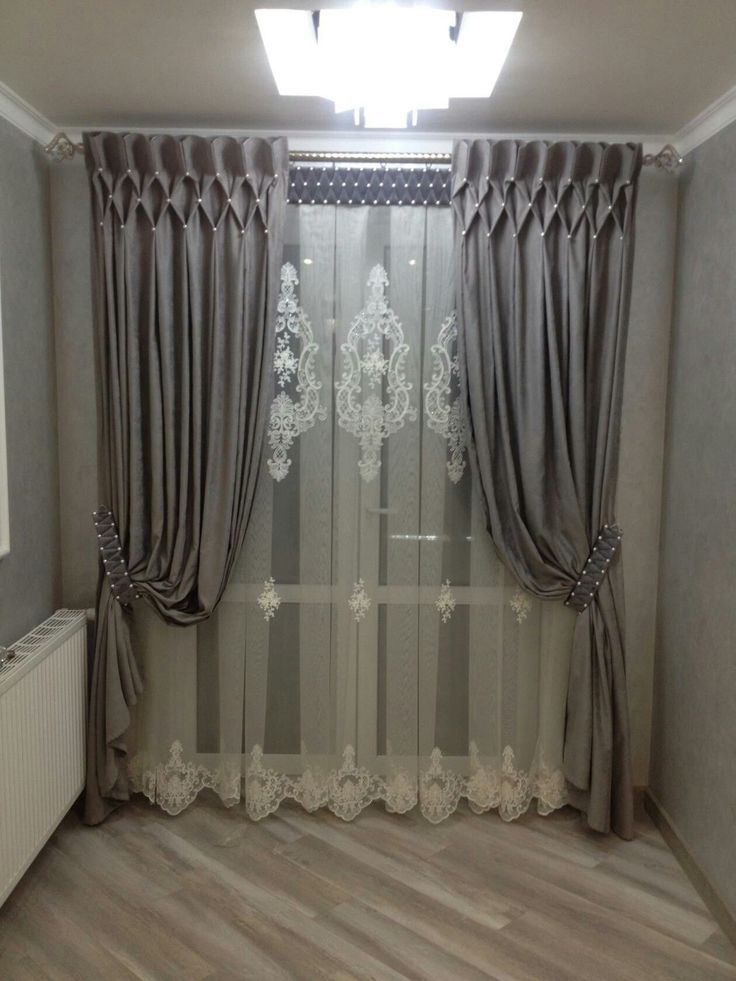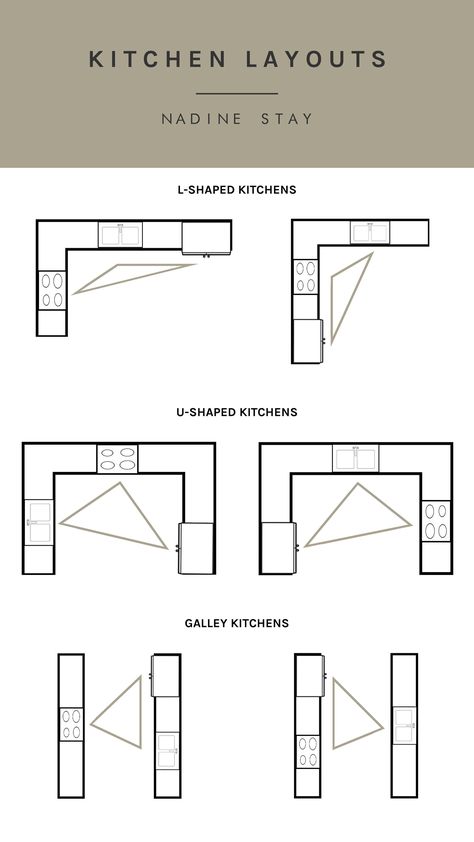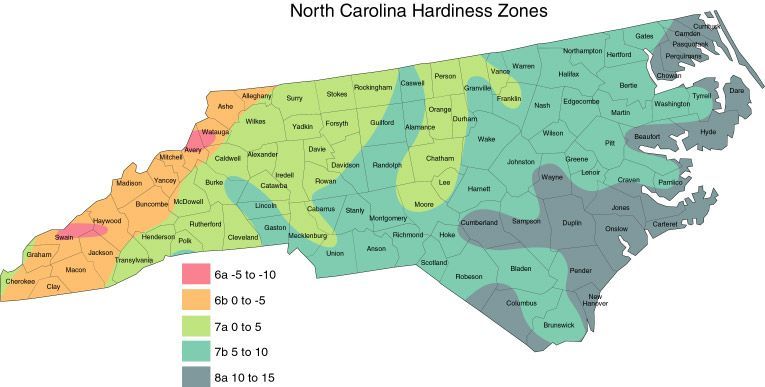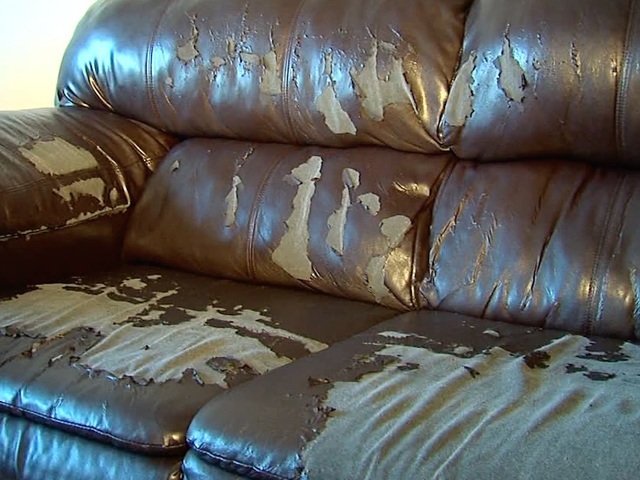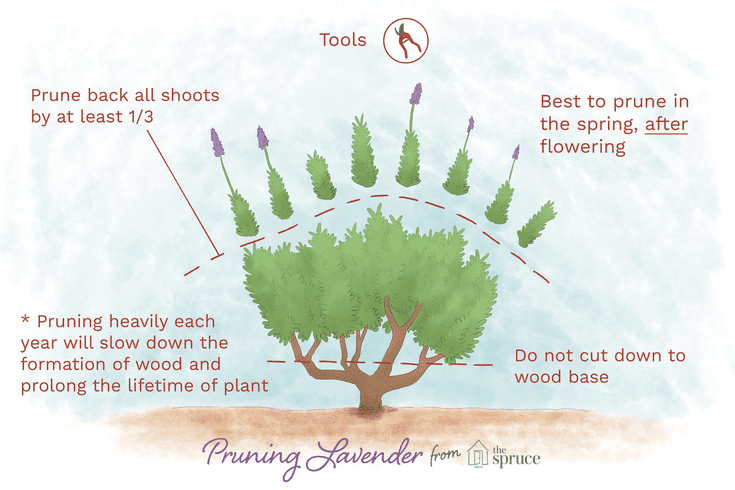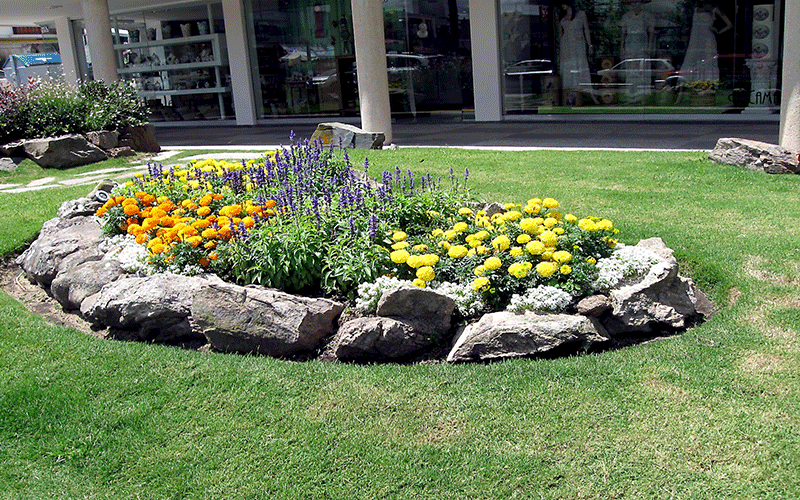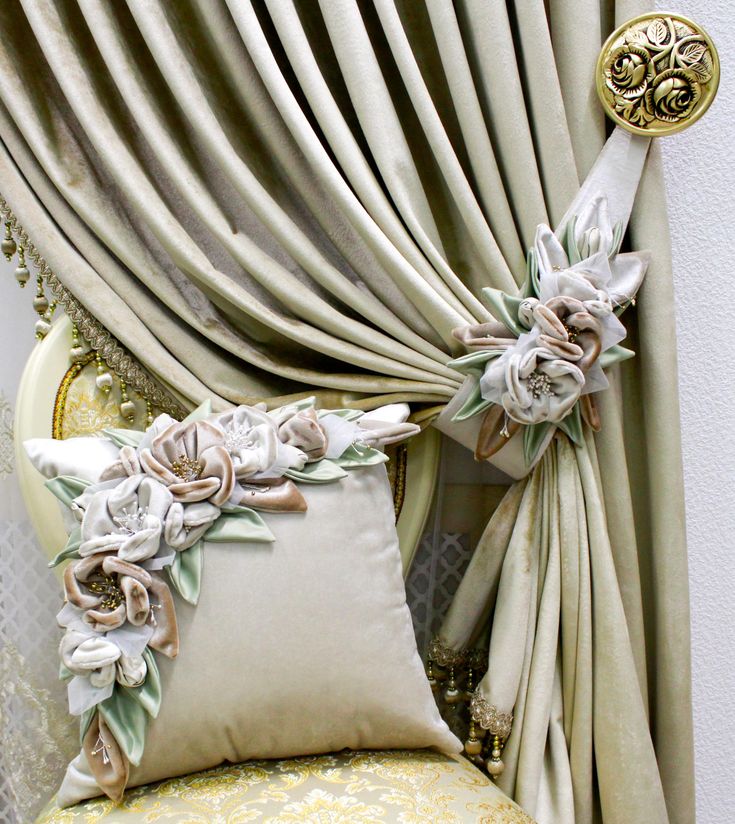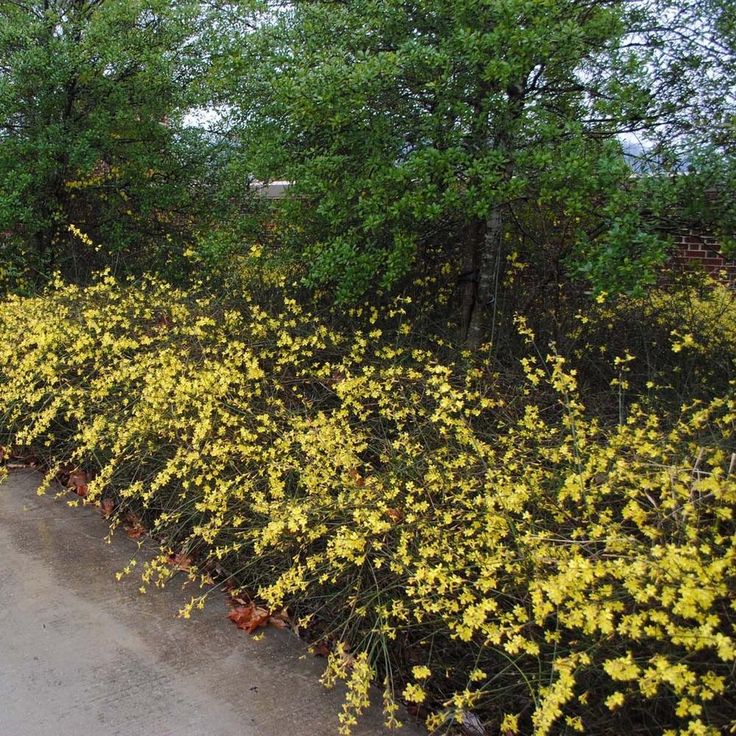Flooring for kitchens advice
Best Flooring for Kitchens in 2023
For years, homeowners continue to choose hardwood—or materials that resemble hardwood—as one of their top options for kitchen flooring. However, with new technology and unique family demands, there are new and innovative solutions for kitchen flooring. You just have to decide what’s the most ideal for your household.
Hardwood Flooring
Hardwood flooring remains a popular choice for kitchen flooring because it gives the home a warm, natural feel. It’s an especially great option for homes with open floor plans. Hardwood flooring can easily blend from the kitchen into a home’s living space.
Traditional wood flooring needs some level of care and maintenance, but more and more manufacturers are using sealers to help protect these classic floors. These finished hardwood floors require less maintenance. You can also try engineered wood flooring. It gives you an authentic wood look with a top veneer that provides more durability.
Tile Flooring
Tile flooring has been a popular option for kitchen flooring for decades. With many options for material (like porcelain, stone, and ceramic), tile gives homeowners a lot of options for customization. Tile flooring comes in a variety of shapes, sizes, and styles; you can even lay it in various patterns for an artistic twist.
Tiles are known to be durable and are a great choice for homes with high-traffic areas. They’re also easy to clean and maintain. One of the drawbacks to tile flooring, however, is the grout in-between. It requires regular resealing to prevent staining. Also, tile flooring can be more expensive than other flooring options.
Vinyl Flooring
Vinyl flooring is a budget-friendly type of resilient flooring, which means it’s known to be pretty soft and comfortable on the feet. It can also be forgiving when accidents occur and someone drops a dish on the floor. Vinyl can come in planks or large sheets, which means installation requires exact measurements and precise cutting. Some engineered vinyl plank options, however, are easy to install and provide added stability and dent resistance.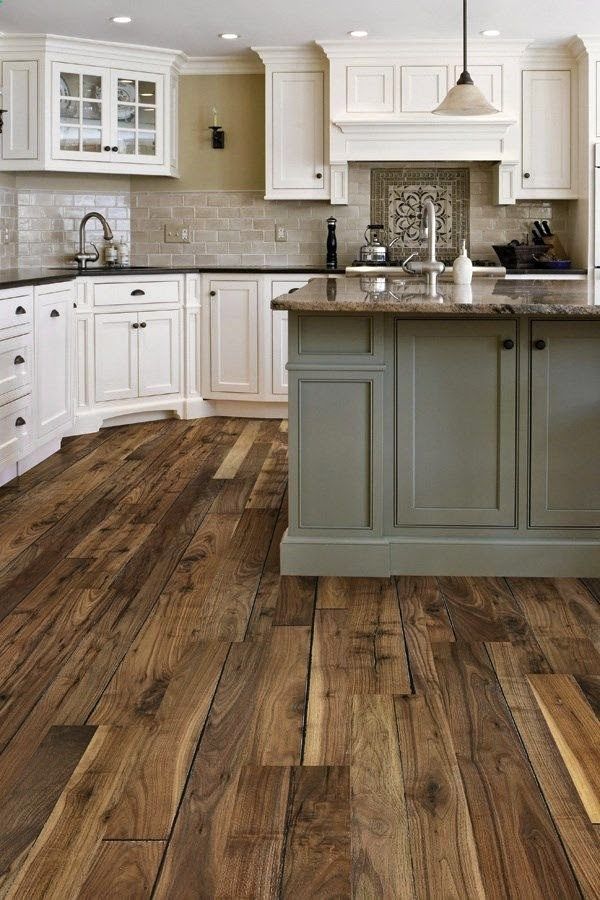
Once installed, vinyl flooring is easy to clean, waterproof, and stainproof. You can choose from a variety of styles and colors, even some options that resemble wood flooring. One con of vinyl flooring, however, is that it can be susceptible to dents from the weight of heavy appliances after long periods of time.
Cork Flooring
Cork flooring is quickly becoming a popular trend in kitchen flooring, as it’s a more comfortable option than some traditional materials. This material has a unique look that can add to your home’s design aesthetic. It’s also an eco-friendly choice for flooring. Cork flooring tiles and planks are made from tree bark, which means they’re sustainable materials.
This warm, soft flooring can help relieve the strain of standing in your kitchen for hours when preparing family meals. Cork flooring is affordable and a great option for the DIY homeowner. However, it is not as durable as other flooring types, sometimes getting dents and scratches more easily. It can require a higher level of maintenance, needing to be replaced every 3-4 years.
It can require a higher level of maintenance, needing to be replaced every 3-4 years.
Get a quote on the best type of flooring for your home today
Best Kitchen Flooring Options Of April – Forbes Home
Renovating a kitchen can be a complicated process. Unlike a bedroom or living room with few built-in components or complicated wiring outside of a TV or computer set-up, kitchens have a lot of considerations; appliances, plumbing, and electricity all have to come together to make the most of the space and ensure that it works safely.
When considering a kitchen remodel, don’t forget your flooring. Flooring should account for approximately 7% of the remodeling budget if you’re tackling the whole kitchen. It needs to be done earlier in the process, too; painting your kitchen walls may come first, but flooring and cabinets need to come before the countertops, backsplash and appliances. While you may be able to DIY some of these, it’s always a good idea to bring in a professional flooring installation company to ensure the job is done perfectly.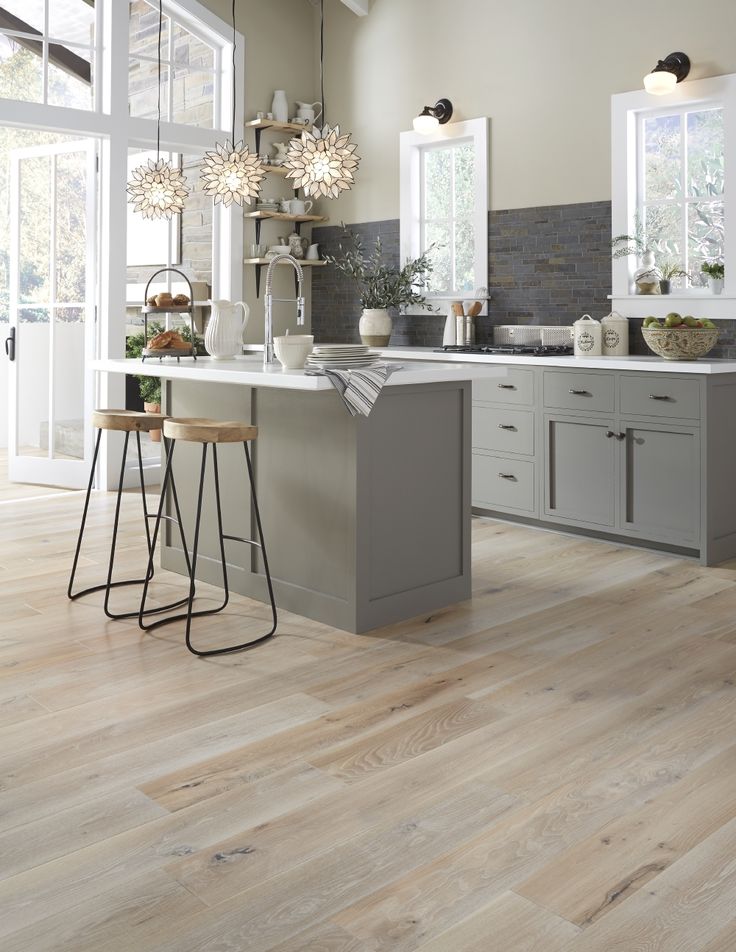 Pros and cons of some of the most common and best flooring options for kitchens are below.
Pros and cons of some of the most common and best flooring options for kitchens are below.
Advertisement
THIS IS AN ADVERTISEMENT AND NOT EDITORIAL CONTENT. Please note that we do receive compensation for any products you buy or sign up to via this advertisement, and that compensation impacts the ranking and placement of any offers listed herein. We do not present information about every offer available. The information and savings numbers depicted above are for demonstration purposes only, and your results may vary.
Compare Quotes From Top-rated Local Flooring Contractors
Free, No-commitment Estimates
Find a Contractor
1. Hardwood
Getty
One of the most traditional options, hardwood is still a popular choice for kitchen flooring today. Although not waterproof, solid hardwoods with the correct finish are water-resistant. Spills should be cleaned up immediately to avoid damage.
Hardwood floors can be refinished to revamp their look, which can especially come in handy if you’re doing a smaller kitchen renovation and don’t want to overhaul the entire floor to make it match the new aesthetic.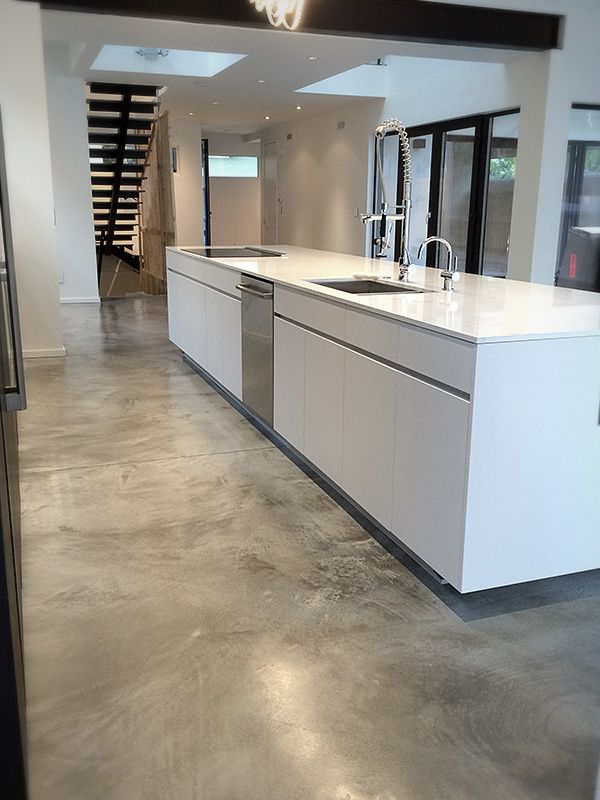 Like tile flooring, hardwood can be laid in different patterns for added interest. Lately, reclaimed, recycled and environmentally sustainable hardwood has been of particular interest.
Like tile flooring, hardwood can be laid in different patterns for added interest. Lately, reclaimed, recycled and environmentally sustainable hardwood has been of particular interest.
Pros
- Many colors and patterns available
- Easy to update
Cons
- Not waterproof
- Can be a slippery surface
2. Tile
Getty
Tile is a go-to option for areas with frequent exposure to water, like kitchens and bathrooms. Ceramic, porcelain and stone tile are all common choices for kitchen flooring options. Tile comes in many sizes and colors and can be laid out in a variety of patterns to suit just about any design theme.
Tile is incredibly long-lasting but in some instances, the grout needs to be resealed to keep it stain-resistant. A DIY approach is not recommended when installing tile flooring.
Ceramic and porcelain tiles are similar; ceramic tiles are even more durable than porcelain.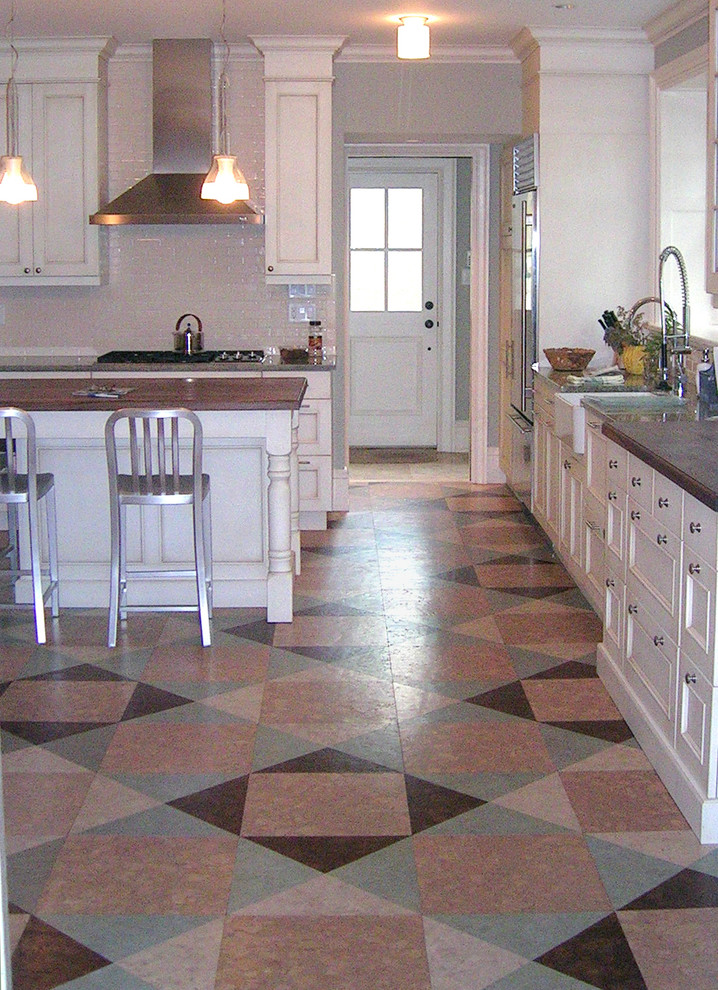 Both are highly resistant to damage, although due to their hardness, dishes dropped on them will likely break, and because of their weight, they are not recommended for a second-story floor. Porcelain, in particular, is waterproof and easy to clean, but tile can be slippery and grout is prone to stains, so any messes should still be cleaned up right away.
Both are highly resistant to damage, although due to their hardness, dishes dropped on them will likely break, and because of their weight, they are not recommended for a second-story floor. Porcelain, in particular, is waterproof and easy to clean, but tile can be slippery and grout is prone to stains, so any messes should still be cleaned up right away.
Stone tile is more expensive and also requires more upkeep than ceramic or porcelain. With the proper care, it can be as tough as other types of tile and it’s also more likely to be non-slip because of its porous surface. Stone tile used in flooring includes travertine, marble, slate and granite.
Pros
- Many colors and patterns available
- Very durable
- Waterproof
Cons
- Can be a slippery surface
- Requires some upkeep
- Should be professionally installed
Advertisement
THIS IS AN ADVERTISEMENT AND NOT EDITORIAL CONTENT.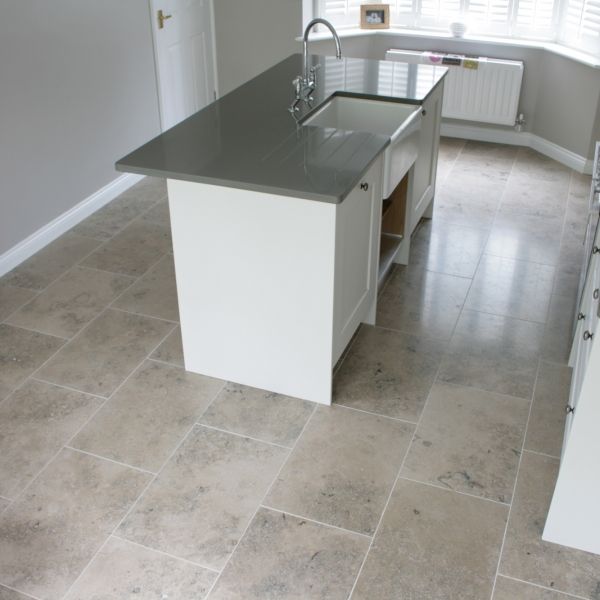 Please note that we do receive compensation for any products you buy or sign up to via this advertisement, and that compensation impacts the ranking and placement of any offers listed herein. We do not present information about every offer available. The information and savings numbers depicted above are for demonstration purposes only, and your results may vary.
Please note that we do receive compensation for any products you buy or sign up to via this advertisement, and that compensation impacts the ranking and placement of any offers listed herein. We do not present information about every offer available. The information and savings numbers depicted above are for demonstration purposes only, and your results may vary.
Using your home's equity is an easy way to fund your new floors!
Get prequalified in minutes by clicking on your state.
Learn More
3. Vinyl
Getty
Vinyl flooring has seen a resurgence in recent years because of the modern upgrades it’s received. Engineered vinyl flooring is now available in tiles and planks that mimic the look of hardwood and stone. It’s completely waterproof, has an almost springy feel underfoot, is incredibly easy to clean and is one of the best kitchen flooring options if you want to take the DIY route.
The biggest drawback of vinyl flooring is that it is softer than other options.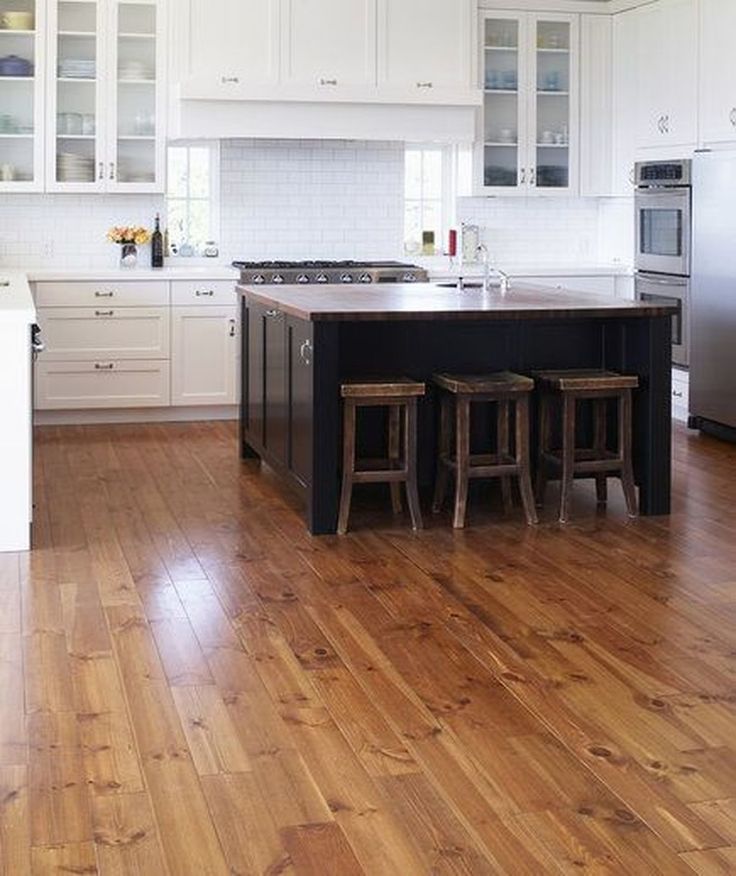 Large appliances can dent or scratch it, so use caution when moving or upgrading things in the kitchen.
Large appliances can dent or scratch it, so use caution when moving or upgrading things in the kitchen.
Pros
- Can mimic more expensive material
- Waterproof
- Can be installed without a professional
Cons
- Not as sturdy as tile
- Can be dented or scratched
4. Laminate
Getty
Laminate has long been a less expensive alternative to hardwood flooring. Like vinyl, it can mimic the look of hardwood for a lower cost; unlike vinyl, it is not always waterproof, but waterproof versions are now available as well. Also, like vinyl, laminate flooring is a great option for DIY installation because the planks can be attached to one another and glued down or “floated,” allowing them to be put over an uneven subfloor.
Pros
- Can mimic more expensive material
- Can be waterproof if a certain kind is used
- Can be installed without a professional
Cons
- Not as durable as other options
- Some kinds are not waterproof
5.
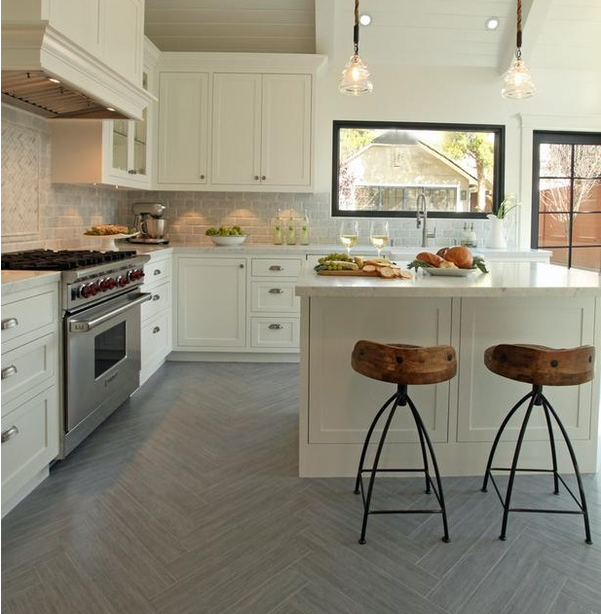 Cork
CorkGetty
Cork is a relatively new addition to the kitchen flooring market, and it’s another budget-friendly DIY option. Cork flooring can be purchased as peel-and-stick, glue-down or snap-together assembly to look like tiles or planks. Unlike many other flooring options, cork won’t feel cold to the touch, and it has a soft, even springy feel, which makes it a good option for absorbing sound.
Made from ground-up cork combined with resins, cork flooring is available in a variety of gray and brown shades. It resists stains but isn’t waterproof; spills should be cleaned up before they can soak in. However, if it does get stained, cork flooring can be sanded down and then retouched with stain and sealer.
The floor can be dented from heavy appliances, but it has the ability to spring back given time. It can also fade in direct sunlight, so closing the curtains during the brightest time of day is recommended.
Pros
- Inexpensive
- DIY
- Absorbs sound
Cons
- Can receive indents from appliances
- Fades in the sun
Advertisement
THIS IS AN ADVERTISEMENT AND NOT EDITORIAL CONTENT. Please note that we do receive compensation for any products you buy or sign up to via this advertisement, and that compensation impacts the ranking and placement of any offers listed herein. We do not present information about every offer available. The information and savings numbers depicted above are for demonstration purposes only, and your results may vary.
Please note that we do receive compensation for any products you buy or sign up to via this advertisement, and that compensation impacts the ranking and placement of any offers listed herein. We do not present information about every offer available. The information and savings numbers depicted above are for demonstration purposes only, and your results may vary.
Compare Quotes From Top-rated Local Flooring Contractors
Free, No-commitment Estimates
Find a Contractor
6. Concrete
Getty
Concrete flooring might sound too harsh for a homey area of the house, but it’s actually a very durable option for the kitchen. Stained concrete can be styled to look like wood, stone or even tile, and it can be sealed to be almost completely waterproof—although mats are still recommended near areas of excessive moisture, like in front of the sink or dishwasher.
One of the biggest perks of concrete is its price; it is a much cheaper flooring option, and since it can be designed to look like something else, it doesn’t have to look inexpensive.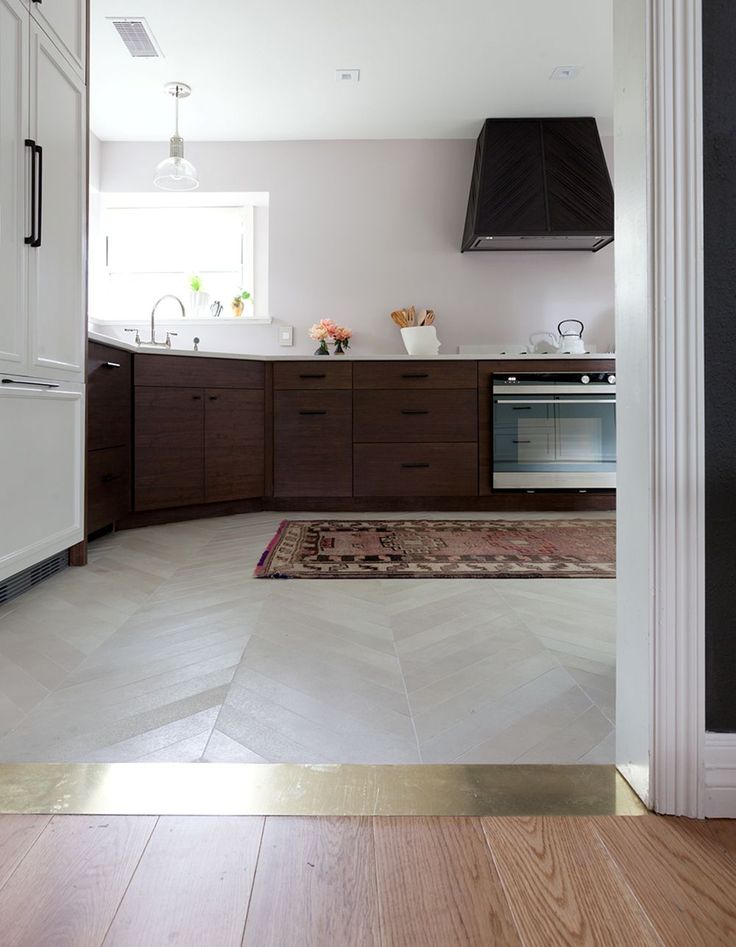
Pros
- Inexpensive
- Waterproof
Cons
- Not as classic as other options
Your Home. Your Decisions. Our Support.
Get expert advice on your home, design tips, how much to pay for pros and hiring experts, delivered to you daily.
{{ newsletterState.emailErrorMsg }}
Thanks & Welcome to the Forbes Home Improvement Community!
{{ newsletterState.emailErrorMsg }}
I agree to receive the Forbes Home newsletter via e-mail. Please see our Privacy Policy for more information and details on how to opt out.
What is the best floor for the kitchen? Tips from PlazaReal in St. Petersburg
During the overhaul of an apartment, the question inevitably arises of what is better to make the floor in the kitchen, what materials are preferable, what can and should not be used for this purpose. We give an overview of the most popular flooring and demonstrate how they look in the interior.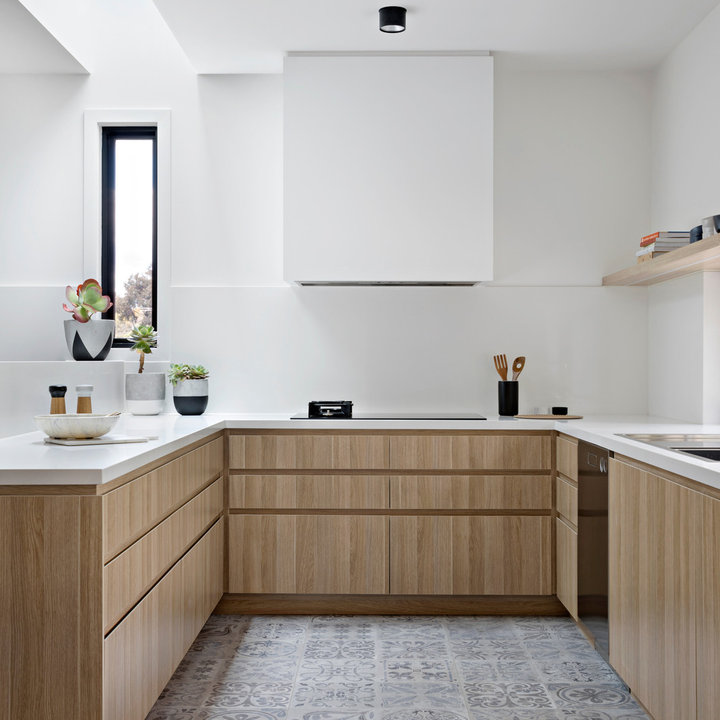
Which floor for the kitchen to choose so that it is waterproof, durable, beautiful and serves for many years? Focusing on the above description, the pros and cons of each material, it will be easy to understand which coating will be the best finishing option in your case:
- Ceramic tiles are based on natural clays of various grades, pressed and fired at high temperature. The most important features are durability and environmental friendliness.
- Vinyl tile is a new generation multilayer material. Produced by hot pressing. Combines the best qualities of laminate and PVC linoleum.
- Porcelain stoneware - made from kaolinite clays, quartz sand, feldspars and coloring pigments. It is fired, acquiring the strength of a monolith.
- Marble is a natural rock formed from limestone subjected to high pressure. The color and pattern depends on the impurities of the minerals copper, chromium, manganese.
- Laminate - 4-layer board coated with paper or cardboard impregnated with resins.
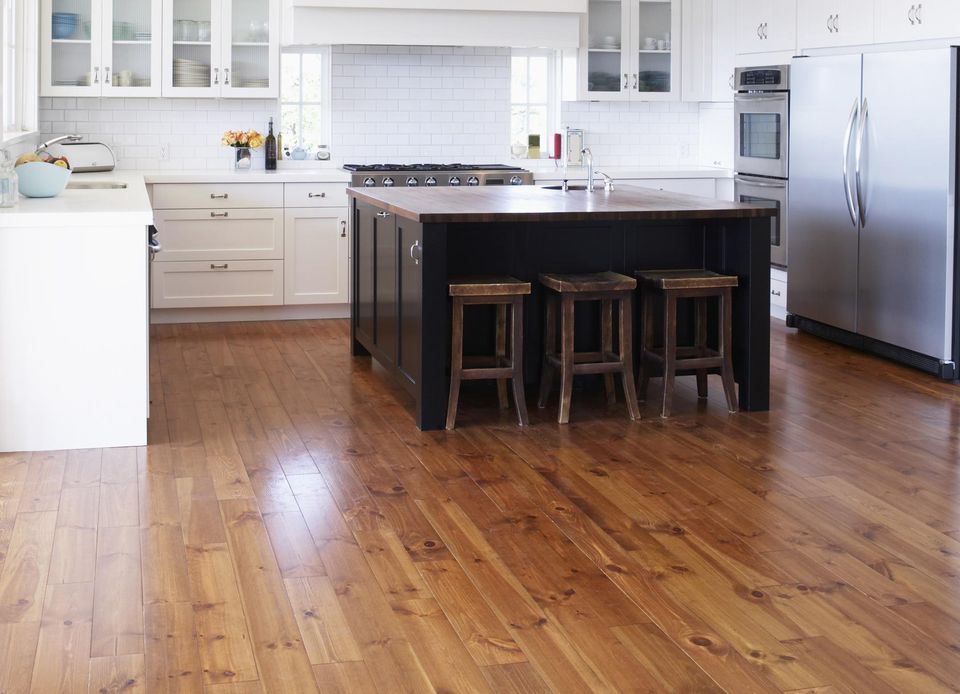 The pattern applied to the surface is covered with a protective film.
The pattern applied to the surface is covered with a protective film. - Cork - cork oak bark, light, practically not abraded, not subject to decay.
- Linoleum - an artificial material on a foamed or monolithic basis of PVC (hard varieties) or on a polyester basis (soft). For the kitchen floor, the first ones are more practical.
Ceramic tiles
Clay tiles have been used for flooring since ancient Roman times. Until today, it ranks first among all types of floor coverings. True, it is not so easy to figure out what is better to put on the floor in the kitchen, because manufacturers offer an incredibly large number of variations of durable and beautiful floor ceramics.
Ceramic tiles for the kitchen on the floor are easily combined with any design style. You can choose an option for both classic and loft or high-tech. Interesting color panels are laid out from it. It is easy to choose an option that imitates natural granite, marble, expensive wood.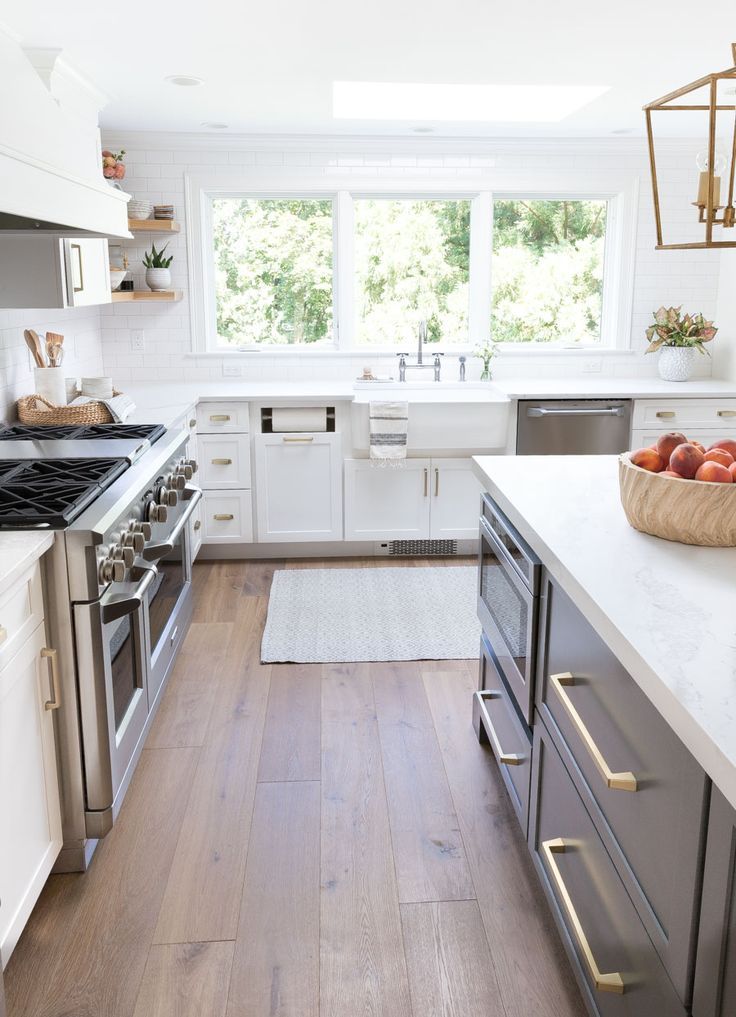
When choosing ceramics, you need to remember that wall tiles for the kitchen are not suitable for the floor, they are used only for wall cladding. As a floor covering, tiles with a hardness of at least 4–5 and a wear resistance index of at least 4 points are used. Then it will serve as long as the life of the building itself is calculated.
The floor is tiled with a trendy geometric pattern.
When figuring out which tile to choose for the floor in the kitchen, you need to remember one important point. This is a place where you can spill anything on the floor: water, juice, vegetable oil (remember Bulgakov's Annushka!). The smooth surface thus turns into a skating rink. If you are concerned about "safety", it is better to pay attention to matte, non-slip tiles.
In fairness, we note or clinker. And one more thing: due to the special hardness, when a glass or crystal wine glass falls on the floor, there are no chances of survival (unlike laminate and linoleum).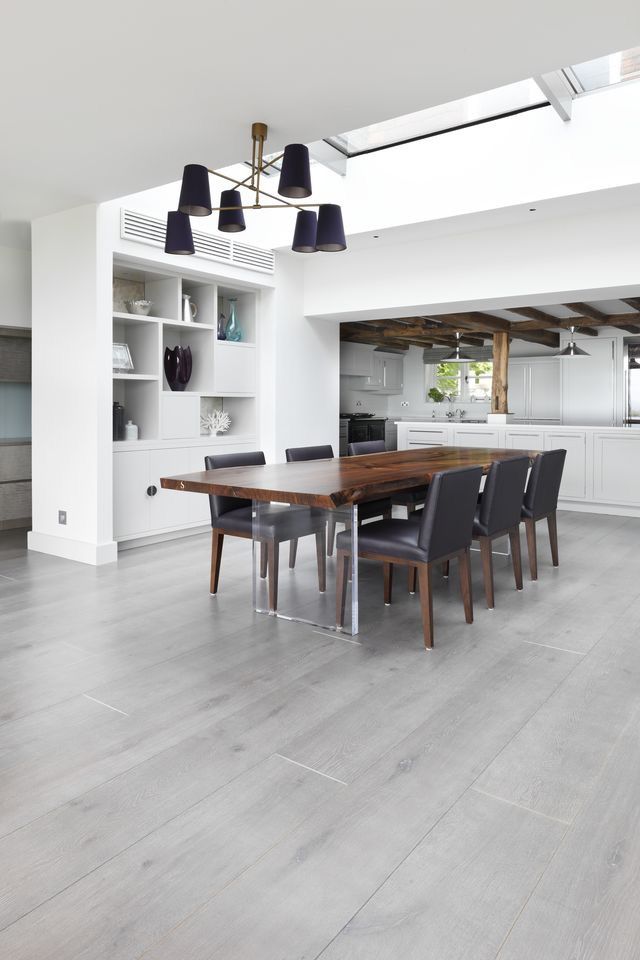
Porcelain stoneware
This modern material appeared only about 30 years ago and firmly "settled" as a floor covering in public buildings and offices. Manufacturers produce various versions of porcelain stoneware, many of which are suitable for laying the floor in the kitchen in private houses and even high-rise apartments.
If, for example, the question is which floor to choose for a country cottage, porcelain stoneware tiles will be in place. It has a fantastic density: in ordinary ceramics, the degree of water absorption is about 10%, and in porcelain stoneware slabs it is less than 0.5%. She is not afraid of frost, has no limitations, a couple of disadvantages of a ceramic floor. It is quite cold, so usually a heating system is provided for it. In this case, you can not use tiles made of red clay: only white is suitable.
Laminate
Wood is not the best choice for covering the floor in the kitchen, as it reacts to moisture and temperature changes.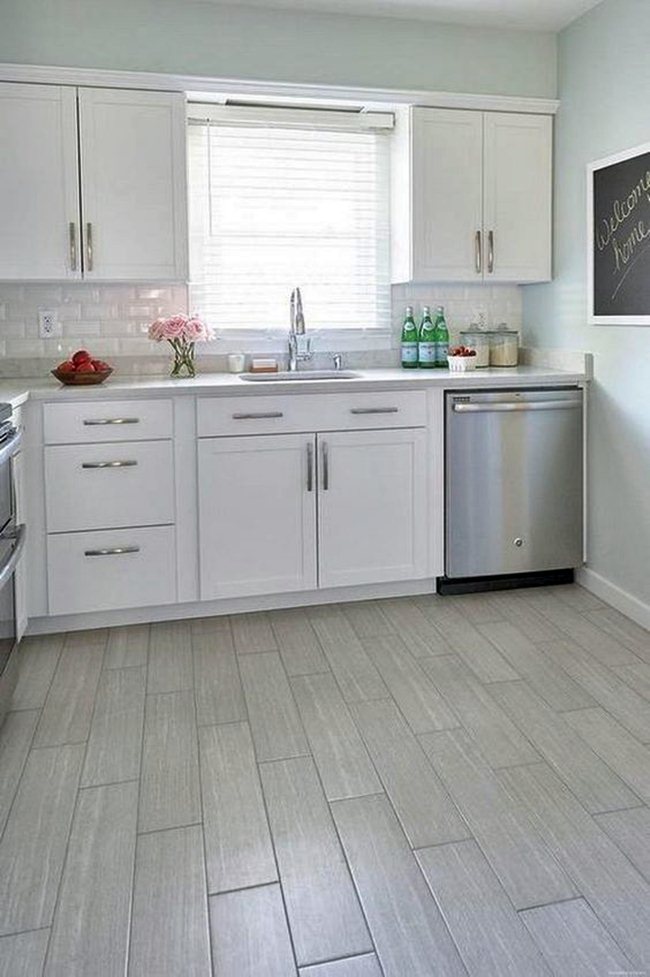 For those who cannot refuse it, or the design suggests a wooden floor, a laminate will be a good alternative. The material is a two-layer plate covered with a moisture-resistant film and decorated with natural wood on the outside.
For those who cannot refuse it, or the design suggests a wooden floor, a laminate will be a good alternative. The material is a two-layer plate covered with a moisture-resistant film and decorated with natural wood on the outside.
Positive qualities: the laminate is difficult to scratch, it retains its shape and original appearance well. Withstands temperatures up to 28⁰C, under such a coating you can safely equip a warm floor. The variety of imitations is huge: from dark oak to light birch, smooth slabs and with a pattern of natural wood. Service life, depending on the class, 15–50 years.
When choosing what is best to lay on the floor in the kitchen, you need to take into account the shortcomings of the material. So, the laminate can not be filled with water when washing. If moisture seeps through the edges, the lamellas will begin to swell. Pay attention to special varieties for the kitchen: a special moisture-resistant wax impregnation is applied to such boards on all sides, including the ends.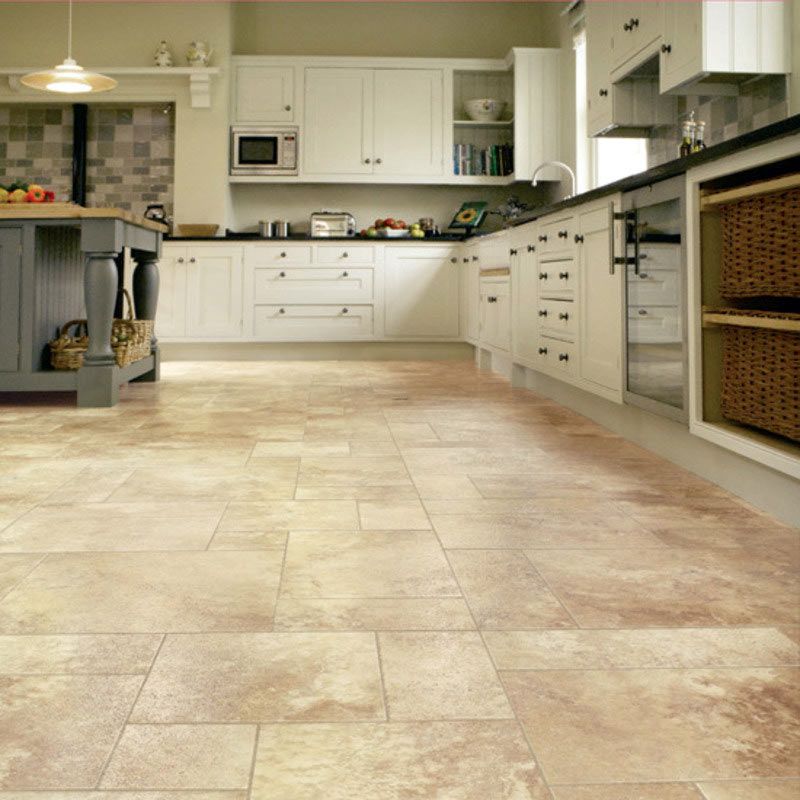
Laminate flooring needs to be laid on a soft substrate, but even this does not save neighbors from noise if you do not like to walk around the house in soft slippers. Do not drop pans and knives on the floor - for all the strength of the material, chips and cracks cannot be avoided in this case.
Valuable quality of a laminate with locks: a damaged board can be easily exchanged for a new lamella, so you need to leave some margin when laying.
Linoleum
When discussing which floor is better to make in the kitchen, we will definitely remember the well-deserved and once very popular linoleum. You should not compare modern varieties of this material with those that were produced twenty years ago. It has a lot of advantages: economical, wear-resistant, has a wide range of colors, is not afraid of moisture.
If you decide that laying linoleum on the floor in the kitchen will be the best option, you need to keep in mind a few rules:
- The subfloor must be level and dry.
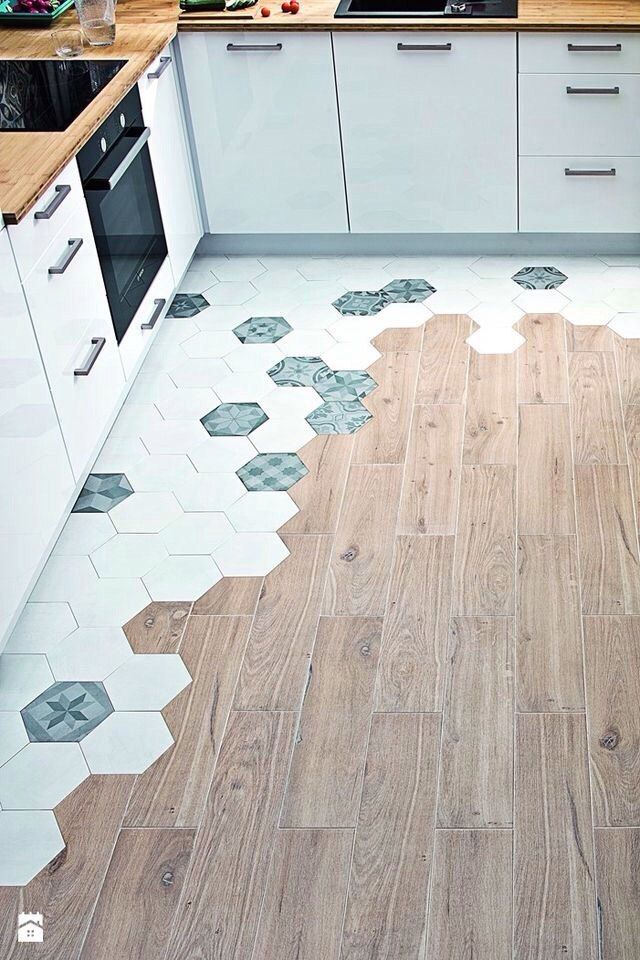 The thinner the linoleum, the stricter the requirements.
The thinner the linoleum, the stricter the requirements. - Small bulges and irregularities will be evident, in addition, linoleum quickly wears out in such places.
- Plain or stone patterned flooring is laid lengthwise away from the window to give the flooring a more uniform appearance.
- When cutting the material, there is always a margin for "cutting" to the walls. Usually it is 5-7 cm.
- After gluing, linoleum must be “rolled” with a heavy roller or a special board.
Today, linoleum is produced not only in rolls, but also cut into tiles. This expands the design possibilities, facilitates the installation of coatings and reduces the number of scraps. The appearance of linoleum is the most diverse. It successfully imitates natural stone, wood, and even metal. Stylish modern prints allow you to choose the flooring option for the kitchen in any style.
Cork floor
The original cork floor in the kitchen is not a cheap pleasure.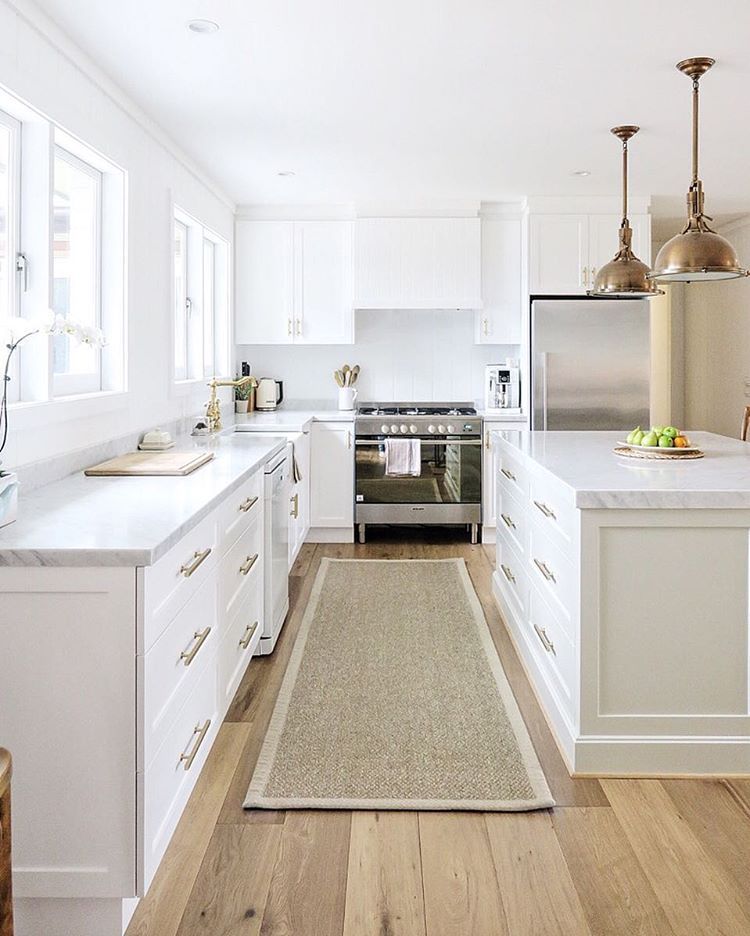 However, it is a very durable and environmentally friendly material. Cork is obtained from the bark of a special type of oak that grows in the Mediterranean countries. It is warm, it is pleasant to walk on it barefoot, perfectly dampens sounds, does not absorb moisture, and is resistant to household chemicals. She is not liked by bugs and other rodents, she is not affected by mold. In addition, such floors have antistatic properties, which means that dust does not accumulate on them.
However, it is a very durable and environmentally friendly material. Cork is obtained from the bark of a special type of oak that grows in the Mediterranean countries. It is warm, it is pleasant to walk on it barefoot, perfectly dampens sounds, does not absorb moisture, and is resistant to household chemicals. She is not liked by bugs and other rodents, she is not affected by mold. In addition, such floors have antistatic properties, which means that dust does not accumulate on them.
Cork is a rare and valuable material, so it is used economically. Two types of floor coverings are made from it. The first is chipboard panels covered with a thin bark veneer (0.5–1 mm). The second variety is more expensive: it is 100% natural material. The bark, crushed into crumbs, is pressed to obtain slabs, which are then decorated with veneer. Such a cork is called granular.
If you have finally found something to lay the floor in the kitchen and cork floor is your choice, please note that the plates must be varnished, or it will need to be applied after laying.
Remarkable quality of a stopper — elasticity. The cork floor is not only pleasant to walk on: it also has a beneficial effect on the musculoskeletal system, reducing the load on the spine.
Vinyl floor
A new interesting material for lovers of experiments - PVC vinyl tiles for the kitchen on the floor. This is a cross between tile, linoleum and laminate. It is quite flexible, easy to install, at the same time comparable in strength to stone, and its decorative possibilities are simply endless. In appearance, the floor can look like granite, marble, there are textures that accurately imitate wood or even leather.
Advantages of vinyl flooring for the kitchen:
- service life up to 35 years, does not fade, does not scratch;
- easy laying, does not require a perfect base;
- is harmless to health, does not emit harmful fumes;
- is not afraid of water, household chemicals, does not slip;
- is a durable material that does not crack on impact.
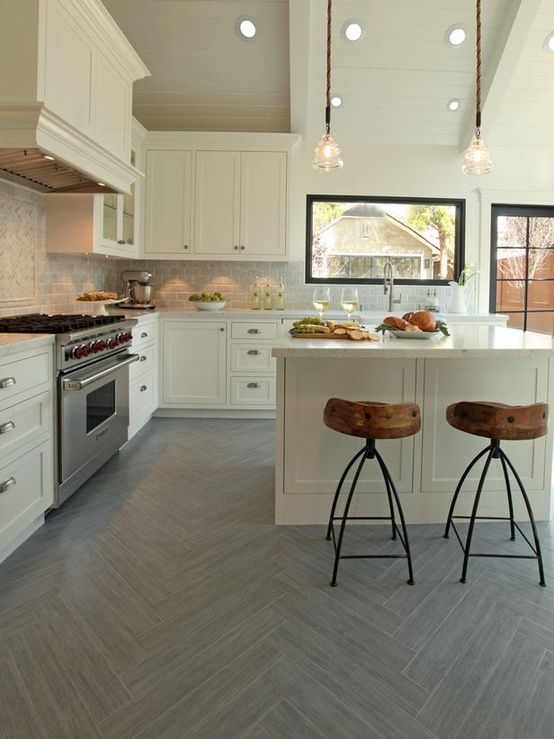
Of the disadvantages of vinyl tiles, only its relatively high cost can be noted. But given the indisputable advantages, it fully justifies itself from all points of view. This is a great alternative to traditional ceramic tiles.
Screed
Under the self-leveling floor in the kitchen, two different operations are meant. More often they mean putting the base in order before laying laminate, carpet or linoleum. This is actually getting a thin, perfectly even screed using a dry water-soluble mixture. If it is brought to a liquid (spreading) state, it is often called self-leveling. Most "levelers" have a porridge-like consistency, which is distributed with a special tool.
The second option for self-leveling floors is the use of mixtures based on polyurethane or epoxy resins, on which, after pouring, you can not lay another coating. The composition can be transparent or colored, various decorative elements are added to it: figurines, shells, stones.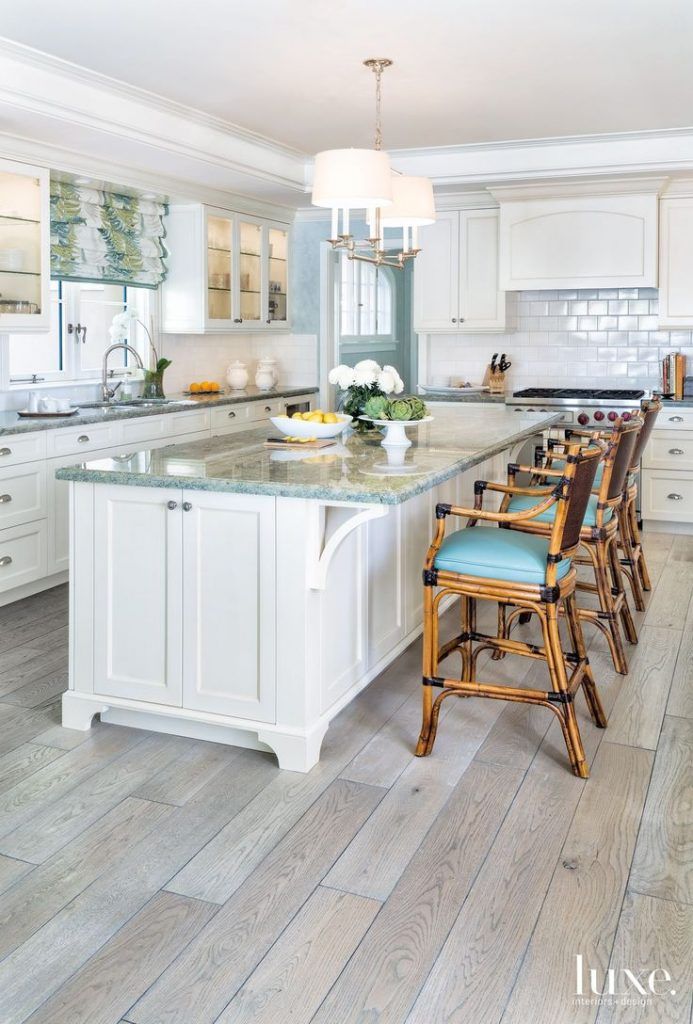 As a result, they get a kind of 3D self-leveling floors, and the kitchen turns into a real work of design art.
As a result, they get a kind of 3D self-leveling floors, and the kitchen turns into a real work of design art.
Marble
Natural marble floor in the kitchen is beauty, elegance, style. But there will be a lot of trouble with him. Both during installation and in subsequent operation. The greatest advantage of marble tiles is that they instantly transform the look of the room, giving it a luxurious, regal look.
Marble has many natural shades, the unique pattern of the stone is not repeated. It is easily cut, polished, acquiring a soft satin sheen. From it you can make any decorative pattern, up to a stone mosaic. It is absolutely safe, environmentally friendly material. However, like any other, it has a number of disadvantages that make it difficult to use in the kitchen:
- Brittle - Dropping heavy objects, especially metal, can cause chips, scratches, and cracks. Eliminating them is difficult.
- Reaction to acids - marble has a calcareous composition, so acidic sauces, wines, juices destroy it and leave indelible stains.

- Polished slabs are very smooth - slipping on the floor is dangerous, and falling on the stone is not very pleasant.
Marble is a porous material, so it is necessary to protect the plates from the penetration of household liquids. It is advisable to consult with experts on which flooring is best for the kitchen in order to prevent staining of the material. Marble tiles are thick and quite heavy. For it, you need to prepare a solid foundation, laying starts from the center of the room towards the walls.
In conclusion, we note which floor to make in the kitchen is up to you. The best solution is at the intersection of practicality, relevance in design and your financial capabilities.
Back to the list of tips
Which floor is best for the kitchen: choosing the material
The choice of flooring is wide: tried and tested for decades or recently appeared materials. Each of them has its own disadvantages and advantages. We've put together a variety of finishes. Let's characterize each one in detail to make it easier to figure out which floor is better to make in the kitchen.
We've put together a variety of finishes. Let's characterize each one in detail to make it easier to figure out which floor is better to make in the kitchen.
Listed all the materials in a short video
How to lay the floor in the kitchen
What should be the flooring
Six options for the kitchen floor
— Tile
– Porcelain stoneware
— Laminate
— PVC
- Tree
— Self-levelling floors
Short summary
As much as one would like to choose a cladding only for its appearance, one must take into account that the kitchen is a “hard” environment. Food is prepared here, so temperature drops, steam and high humidity are not uncommon. It is undesirable that this negatively affects the condition of the coating. Sometimes the food burns or initially has a strong odor that can be absorbed into the pores of the finish.
During cooking, liquids may spill or food may fall on the surface: greasy or colored stains will remain, which should be easily removed.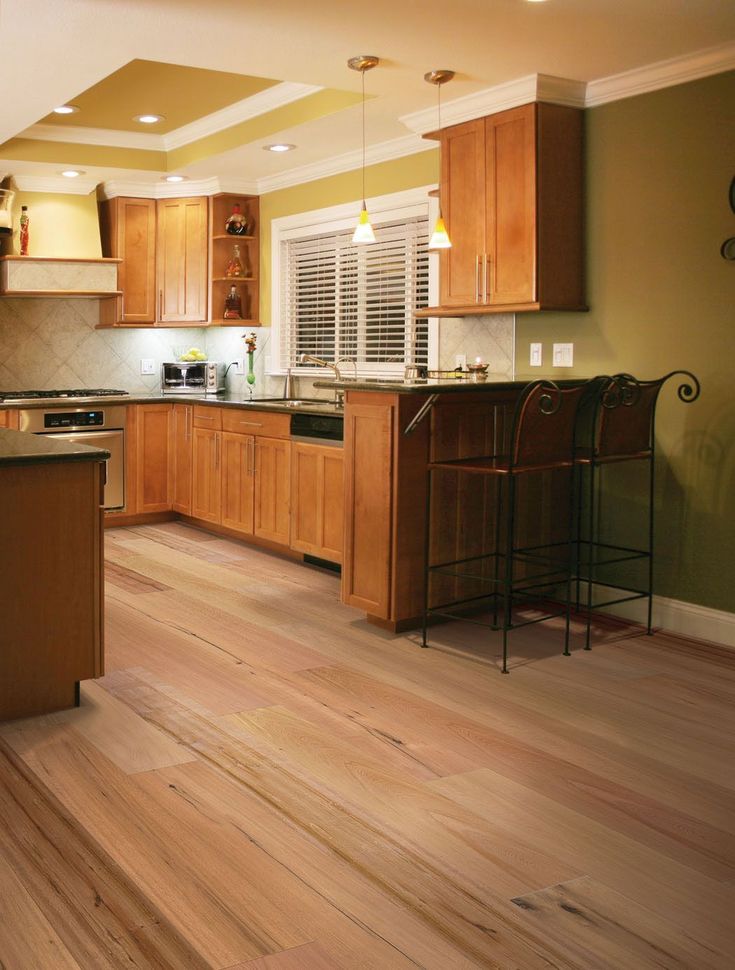 Even spilled water can ruin the wrong finish. Heavy and sharp objects also often fall on the kitchen floor. Dishes fall from time to time. In order for it to remain intact, there must be a soft finish on the floor, on hard glass or porcelain will scatter into small crumbs.
Even spilled water can ruin the wrong finish. Heavy and sharp objects also often fall on the kitchen floor. Dishes fall from time to time. In order for it to remain intact, there must be a soft finish on the floor, on hard glass or porcelain will scatter into small crumbs.
And one more very important point. The finish should be easy to clean and withstand multiple cleanings. In the kitchen, stains and dirt can be very serious here. Therefore, not only soft soap is used, but also aggressive chemicals. It is better if the pollution is not very noticeable. For example, on a very dark or very light glossy finish, every crumb or speck of dust is clearly visible. It is better not to choose them for the kitchen.
Pexels
Despite the fact that the requirements for flooring are many, the choice of materials is very wide. We offer a selection of options from which it is better to make a floor in the kitchen.
1.
 Ceramic tiles
Ceramic tiles The traditional kitchen floor solution. It is moisture resistant, not afraid of temperature changes and pollution. It is easy to wash off stains, provided that the lining is not porous. The design of the tile is varied. It can be monophonic, color, imitate various materials. Tiles are available in different sizes. Ceramics are well combined in color, size and shape.
Tiles are not perfect. First of all, its surface is always cold. The situation is saved by the underfloor heating system laid under it, but this is not always possible and beneficial. Also, ceramics are brittle. A dropped knife or heavy pot will almost certainly chip or even split the tile. It can be replaced, but it's troublesome. Glass or porcelain dishes will not withstand a fall on the tile.
But, in general, ceramic tiles are one of the most practical solutions. It is not afraid of water and pollution, without loss of appearance withstands numerous cleanings and washing. The price is quite affordable.
Design: Anna Elina. Photo: Evgeny Gnesin
Design: Anna Elina. Photo: Evgeny Gnesin
2. Porcelain stoneware
This is a type of ceramic tile with increased strength and durability. When laid, it easily tolerates blows; it is rather difficult to split or chip off a fragment from it. Therefore, falling knives and heavy utensils are not terrible for porcelain stoneware. Insensitive to moisture and temperature changes. Can be installed in damp areas. Available in different designs: imitations of natural wood or stone are good, but there are other options. Combined in size, shape and color.
The disadvantage of porcelain stoneware is that the surface is cold to the touch. Walking barefoot on it is unpleasant, but the underfloor heating system saves the situation. If it is not possible to lay it, then it is better not to mount porcelain tiles on the ground floor or in a private house. The material is very hard, which means that the dishes that fall on it will break into smithereens. Plus, it's slippery. Therefore, it is necessary to choose a tile with anti-slip treatment.
The material is very hard, which means that the dishes that fall on it will break into smithereens. Plus, it's slippery. Therefore, it is necessary to choose a tile with anti-slip treatment.
Porcelain stoneware is well suited for the kitchen. It is easy to clean, does not deteriorate from water, does not absorb odors, durable and beautiful. The price is slightly higher than that of ceramics.
Design: Ksenia Konovalova. Photo: Olga Shangina
3. Laminate
These are sandwich panels based on wood-based interlocking panels. Easy to fit, warm to the touch, easy to care for. It's nice to walk on them. Dishes that have fallen on the laminate will most likely remain intact. The colors and textures are very different, usually it is a good imitation of natural wood of various species, cork surface. High-quality models are durable, environmentally friendly, do not fade or deteriorate under the influence of moisture.
The weakest point of laminate flooring is the interlocks. This is where moisture can get inside the base. This leads to irreparable damage to the coating: it deforms and swells. In addition, for inexpensive models, the edges of the laminated film move away over time. They lift up and fly off, revealing the base. The panels are not sufficiently resistant to mechanical damage. For example, a knife falling from a height will certainly damage the surface.
Laminate panels are a possible but not the best choice for kitchen flooring. They deteriorate from moisture, are sensitive to shock, and do not tolerate frequent washing. It is best to combine them with other coatings. For example, lay out strips of porcelain stoneware near the kitchen set, and decorate the area under the dining table with laminate.
4. PVC tiles
PVC tiles are made from polyvinyl chloride with various additives. The most famous variety is quartz-vinyl cladding. About 80% quartz sand is added to it, which gives increased strength. The properties of vinyl tile are closest to linoleum. It is quite soft, moisture resistant, pleasant to the touch, resistant to mechanical stress. It cannot be split, but you can get dents under heavy furniture. Two types of PVC tiles are produced: with locking joints and for laying on glue. There are a lot of design options: sizes, shapes, textures and colors are very different.
About 80% quartz sand is added to it, which gives increased strength. The properties of vinyl tile are closest to linoleum. It is quite soft, moisture resistant, pleasant to the touch, resistant to mechanical stress. It cannot be split, but you can get dents under heavy furniture. Two types of PVC tiles are produced: with locking joints and for laying on glue. There are a lot of design options: sizes, shapes, textures and colors are very different.
The material has few significant drawbacks. One of them is careful preparation for installation. The base must be perfectly level and dry. Otherwise, all defects will be noticeable after installation. For castle models, these requirements are less stringent. Another disadvantage is the high price of PVC tiles. But we must understand that it will last a long time and will not lose its attractive appearance and properties during the entire period of operation. If repair is still required, the damaged element can be easily replaced.
Vinyl is a good choice.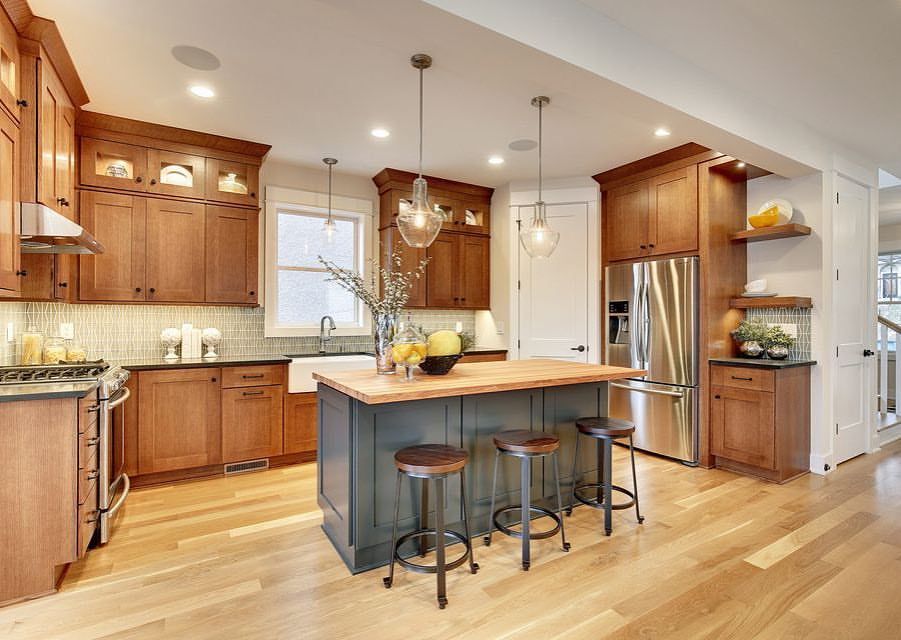 He is not afraid of water, frequent cleanings, does not deteriorate from aggressive chemistry. Soft lamellas are pleasant to the touch, retain sound and heat.
He is not afraid of water, frequent cleanings, does not deteriorate from aggressive chemistry. Soft lamellas are pleasant to the touch, retain sound and heat.
Pexels
5. Wood
A very beautiful and ecological option. Hardwood floors are strong and durable, provided they are properly installed and treated. It can be parquet, planks of different shapes or boards made of wood of different species. Depending on the type of wood, the properties of the finish vary slightly. But in any case, it is a stylish and expensive decor, warm and pleasant to the touch. Scratches and other defects that appear on its surface can be removed without a trace.
The main disadvantage of wood is its high hygroscopicity. It absorbs moisture and under its influence begins to deteriorate. A fungus or mold appears, the tree rots and collapses. Therefore, regular treatment with special solutions is required. In addition, the wooden surface burns, it must be protected from fire. Strong mechanical influences are undesirable. There may be chips and scratches. True, it is quite easy to get rid of them.
Strong mechanical influences are undesirable. There may be chips and scratches. True, it is quite easy to get rid of them.
With all the advantages of the material, without special treatment, it cannot be laid in the kitchen. Changes in humidity and temperature will quickly make the wood unusable. It is best to choose a thermal tree. This is the name of the material processed under special conditions. It is most resistant to moisture and other adverse factors.
Design: Natalia Shirokorad
Design: Victoria Baikova. Photo: Natalya Vershinina
6. Self-leveling floor
This is a liquid self-leveling mastic poured onto the base. Usually on a concrete screed. After hardening, a durable wear-resistant coating is formed. The self-leveling floor is immune to impacts, you can put massive furniture on it, drop sharp and heavy objects. There are no traces left. It is completely sealed and waterproof. It is very easy to clean because it does not attract dust. The surface is smooth and easy to clean. You can use any household chemicals.
There are no traces left. It is completely sealed and waterproof. It is very easy to clean because it does not attract dust. The surface is smooth and easy to clean. You can use any household chemicals.
Liquid mastics come in a variety of colours. An interesting decor is obtained using the so-called 3D-paintings, but you should be careful with the choice of image: the image of an aquarium, a forest or mountain path, a desert is already completely irrelevant and can reduce the cost of the interior.
A significant disadvantage of flooring is the dependence on the quality of installation. Even a high-quality mixture can ruin unskilled installation. It is impossible to hide flaws when laying. The downside is usually considered the high price of decor and the fact that self-assembly is not always possible.
Self-leveling coating suitable for kitchen floors. It is durable, moisture and wear resistant, not afraid of temperature extremes and mechanical damage. At the same time, it is easy to care for him.

